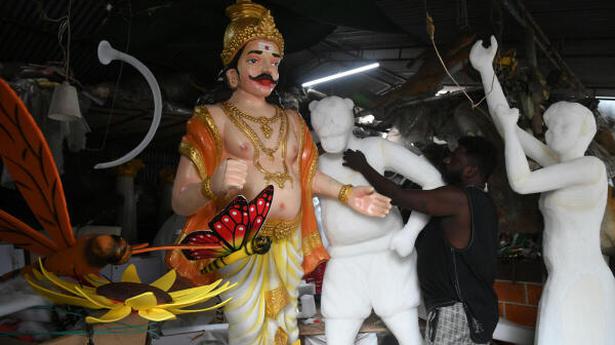
The makers of Mahabali
The Hindu
As Onam approaches artisans update tradition this year, from using more eco-friendly material to sculpting Mahabali with a six pack
A six-foot high figure of King Mahabali stands tall in a large shed in Kaloor. The mythological King of Kerala is waiting to be dispatched to a shopping mall where his presence will usher in the spirit of Onam. Another good-to-go Mahabali, is being carried by two bearers to a truck. An artisan is engrossed chiseling a polyfoam figure of a pulikali dancer, while chenda players and Thiruvathira figures await final sculpting. Long, bright orange dragonflies dangle from worn out pipes, and a row of yellow, foam, sunflowers too are ready for dispatch.
Walking through the shed of Ameya Events means skirting around reams of polyfoam, tins of adhesive, stacks of metal frames and corrugated sheets, bags of smiley rubber balls and pails of enamel paints and emulsions. A smell of resin adhesive pervades the air and a Malayalam song from an artist’s phone binds the six men who are racing against time to complete Onam décor orders from large stores and malls in the city.
“The artists have been working day and night,” says Vipin KM who started the firm 15 years ago. “We have made six Mahabalis so far and many pulikali and Thiruvathira dancers.” Other Onam related characters and motifs in their inventory are figures of Vamana, snake boats, the traditional Kerala meal or sadya, upperi (banana chips), banana, pookalam(flower carpet), Theyyam and Kathakali masks. Most of the supermarkets, stores and malls want the Onam decor to be up before Atham(August 30).
Biju PD, “our main artist”, (as Vipin says) is self-taught. He has been making the figures for the past 12 years and has noticed changenot only in materials used but also in design.
“The Mahabali is no longer potbellied. We now make him muscular,” he says. Vipin adds that the “cartoon look” of Mahabali that was common a decade ago, is no longer accepted. “The new generation wants a figure with six packs. Ours is six feet tall and well built.”
Changes in materials include Thermocol giving way to polyfoam, which is sturdier and does not break easily. “It is also environment-friendly,” says Vipin. Earlier Plaster of Paris was commonly used but is replaced by fibre. “We also use coir, bamboo, corrugated board, jute and rubber foam. Resin used on canvas or with fibre becomes a hard and durable material,” he says.
Increased awareness of the environment sees figures are stored away and reused. All waste from the craft is taken away by recyclers from Chennai.











